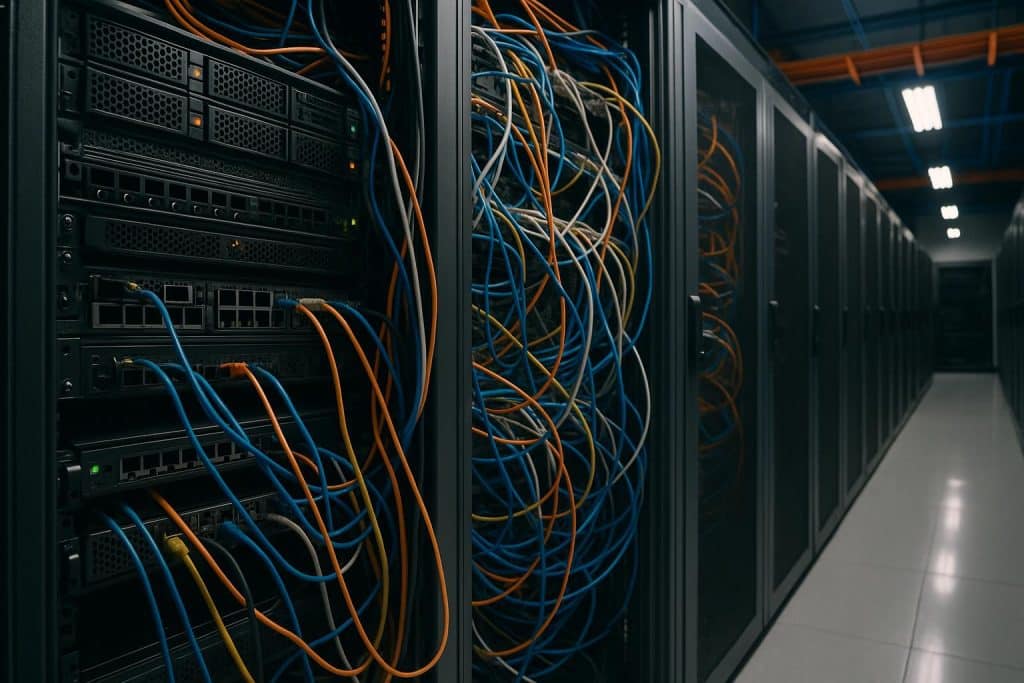Modern businesses, institutions, and infrastructure projects rely heavily on network systems. These systems process data, store information, and ensure that digital services remain available. Because IT hardware is highly precise and sensitive, even minor external influences can trigger common server issues such as downtime, malfunctions, or data loss. To remain competitive, companies must understand the most common data center problems and know how to prevent them.
Typical Data Center Issues
All common server problems can be grouped into two categories: physical and technical. Both require attention, since neglecting either side can lead to costly downtime and reputational damage.
Physical Data Center Issues
1. Power Failures Among the top data center issues, power outages and surges are the most disruptive. They cause workflow interruptions, data loss, and expensive downtime. Even after power is restored, servers often require additional time to reboot and synchronize. Every minute of downtime translates into financial losses and reduced customer trust. Solution: Install uninterruptible power supplies (UPS), backup generators, and redundant power lines to ensure continuous operation.
2. Environmental Factors The environment surrounding servers directly impacts performance.
- Dust and debris accumulate inside racks and a server cabinet, blocking airflow and reducing cooling efficiency, which leads to overheating
- Humidity and temperature fluctuations create additional risks: low humidity increases static discharge, while high humidity causes corrosion and condensation on circuit boards. Both scenarios can disable equipment for days.
Solution: Use enclosed racks or protective panels to minimize dust penetration, install climate sensors to monitor humidity and temperature, and deploy efficient cooling systems. In some cases, open‑frame racks can improve airflow and reduce overheating risks.
3. Outdated Equipment Technology evolves rapidly, and firmware or hardware can become obsolete within a few years. Outdated systems often run slower, are more vulnerable to errors, and may not support modern security protocols. Solution: Regularly update firmware, replace aging devices, and plan hardware refresh cycles to maintain efficiency.
4. Physical Damage Servers, cables, and cooling units can be damaged accidentally during maintenance or intentionally by intruders. Solution: Use durable, shock‑resistant enclosures, restrict access to server rooms, and implement security measures such as biometric locks, access cards, and surveillance cameras.
Technical Data Center Issues
1. Cybersecurity Threats One of the most critical common server issues is data theft. Hackers target servers to steal sensitive information. Cyberattacks can result in stolen data, financial losses, and reputational damage. Solution: Deploy advanced security software, apply regular patches, and involve cybersecurity specialists to design multi‑layered defense systems.
2. System Overload When too many users rely on a single server, performance drops, applications freeze, and errors appear. This reduces employee productivity and frustrates customers. Solution: Conduct professional capacity assessments, balance workloads across multiple servers, and consider cloud or hybrid solutions for scalability.
3. Misconfiguration Even a small error in server configuration can disable entire systems. Incorrect settings often remain unnoticed until they cause downtime. Solution: Double‑check configurations, document changes, and perform regular audits to ensure accuracy.
4. Network Failures Unstable internet connections are among the top data center issues, disrupting communication between systems and users. For businesses, this means interrupted services and dissatisfied clients. Solution: Partner with reliable internet service providers, use redundant connections, and monitor network performance continuously.
Conclusion
Most common data center problems can be avoided with proactive monitoring, preventive maintenance, and careful configuration. By addressing both physical and technical risks, businesses can minimize downtime, protect valuable data, and ensure that their IT infrastructure operates reliably. In today’s digital economy, solving common server issues is not just about technology — it’s about protecting business continuity and customer trust.
